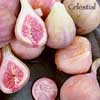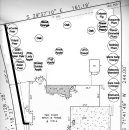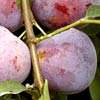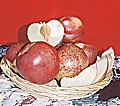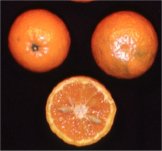
|
'Ponkan' ('Warnurco', 'Chinese Honey') apparently originated in India where seedlings orchards are still widely grown. It is believed to have been sent to Florida from China in the early 1890's. Its fruit are generally large for mandarins, having orange rind and flesh. The flesh is tender and melting, with mild flavor and aroma.
Fruit large (for a mandarin), globose to moderately oblate; base commonly with strong furrowed but relatively short neck or low collar; apex usually deeply depressed and with radiating furrows; sometimes with naval. Rind medium-thick, fairly loosely adherent; surface relatively smooth but pebbled, with prominent, sunken oil glands; orange-colored at maturity. Segments about 10, easily separable; axis large and hollow. Flesh color orange; tender and melting, juicy; flavor mild and pleasant, and aromatic. Seeds few, small, plump, and polyembryonic; cotyledons light green. Early midseason in maturity. Loses quality and rind puffs if not picked when ripe.
Harvest Dec - Jan.
|
